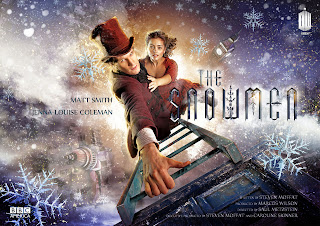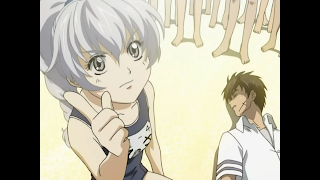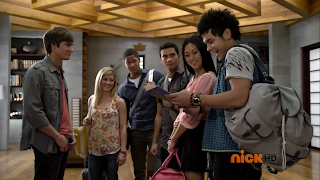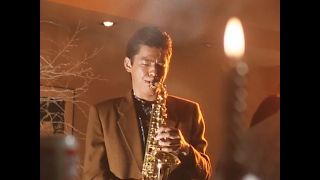 |
| The Astro Megaship crew - Carlos, Cassie, Andros, Ashley and TJ |
Following on from the events of Turbo; TJ, Cassie, Ashley, Carlos and Alpha 6 have jetted off into space with the intent to save Zordon from Dark Specter and his United Alliance of Evil (including previous villains Zedd, Rita, the Machine Empire and Divatox). During their long space flight they are pulled onto the Astro Megaship and meet Andros, an alien from the space colony KO-35 and red space ranger. Though he has the same goal as the four Earth ranger, Andros is initially dismissive of the team and refuses to let them help him. Following an attack by Astronema, the new Princess of Evil, and her army of Quantrons, he presents the team with Astro morphers. Later they discover that the NASADA shuttle they travelled in can combine with the Astro Megaship to form the powerful Astro Megazord.
Together, the space rangers search the galaxy for Zordon while also defending the Earth from Astronema's attacks. Later they are aided by Zhane, the silver space ranger who has spent the last two years in cryogenic sleep. But their battles against Astronema take a turn for the worse when she is revealed to be Karone, Andros' younger sister who was taken away from him as a child.
 |
| Yes, this happened. Move along. |
With viewers already familiar with the cast of Turbo, the majority of the character development goes to Andros. While his past with Zordon is never fully revealed, we learn a considerable amount about his traumatic childhood, battles alongside the silver ranger and then relationship with his lost sister. With a Zordon-type character absent for the first time, he also acts as a sort of mentor for the early episodes where the Earth rangers still get used to their new powers. That isn't to say the others don't get a fair share of focus though, and while there isn't a full team-episode due to the continued cast, Justin (as the Blue Turbo ranger) and Adam (as the original Black ranger and thus revealing the state of the dino power coins) return for two excellent episodes. There's also an early crossover with the Teenage Mutant Ninja Turtles (as Saban's Turtles: The Next Mutation was airing at that time), but the less said about that the better.
 |
| Astronema, in one of her many many wigs. |
As if the appearance of nearly all the villains of Power Rangers past wasn't tantalising enough, Power Rangers in Space is also more than capable of holding its own when it comes to new villains. Leading the charge is Astronema, a ruthless empress raised in the ways of evil from a child. Her right-hand man, the loyal warrior Ecliptor, repeatedly clashes in an excellent rivalry with Darkonda, a treacherous alien responsible for Karone's kidnapping with goals of eventually taking the universe for himself. The quality of villains is so good here that Elgar needed to be brought back from Turbo to balance things out in terms of comic relief. The only real weak link is the "Grand Monarch of Evil" himself - Dark Specter. While the Maligore costume was excellent and severely underused in Turbo: A Power Rangers Movie, seeing it return feels lazy and doesn't really offer much apart from some observational gags from Divatox. The character is supposed to strike fear into both heroes and villains across the galaxy, but never properly meets the rangers themselves, never actually does anything except bark orders and then suffers a very cheap death. Arguably his background role allows the more important characters to shine, but given his title I expected a little more.
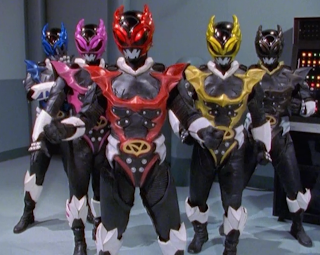 |
| The Psycho Rangers |
One of the best arcs of the season also involves the Psycho Rangers, finally giving fans what they wanted - PROPER evil Power Rangers. Relentless fighters and determined to destroy their respective colours, this story arc sees the space rangers completely overpowered and having to resort to new tactics in order to beat them. Great designs, both in ranger and monster forms, and among the most notable adversaries in Power Rangers history.
Power Rangers in Space does a number of things slightly differently to previous seasons', and the new zords are no exception. Instead of the usual five-vehicle combinations, the first two megazords (the Astro and Delta Megazords) are single spaceships that transform into complete robots (with the Astro Megaship also serving as the series base). It isn't until the Mega Voyager rolls around that individual vehicles appear again, and even then the combination is more innovative than the usual torso plus limbs format.
 |
| The Astro Megaship |
Finally we come to Bulk and Skull, who's character development draws to a close in the finest of ways. Appearing far less than they do in previous seasons - Skull in fact seems to have barely any lines, In Space sees the two teaming up with eccentric scientist Professor Phenomenus in search of aliens and UFOs (which is a little strange given Angel Grove has been under constant alien attack for the last six years). However it is the series finale that the two have their finest hour. As Astronema takes the city hostage and tells the rangers that if they don't reveal themselves the people will die, Bulk and Skull step forward proclaiming to be rangers and then later lead the citizens of Angel Grove against Astronema's forces. These are no longer the bullies they were at the beginning of Mighty Morphin Power Rangers, proving that you don't need superpowers to be true heroes.
 |
| Bulk & Skull with their new friend Professor Phenomenus |
Had it truly been the end, Power Rangers in Space would have been the perfect end to the Power Rangers franchise. The stakes are higher, the format more innovative and the characters better developed. The two-part Countdown to Destruction remains the single best season finale the franchise has offered to date. Not only is it a satisfying close to the Zordon-era of Power Rangers, but an extremely enjoyable series that is able to stand on its own two feet.




